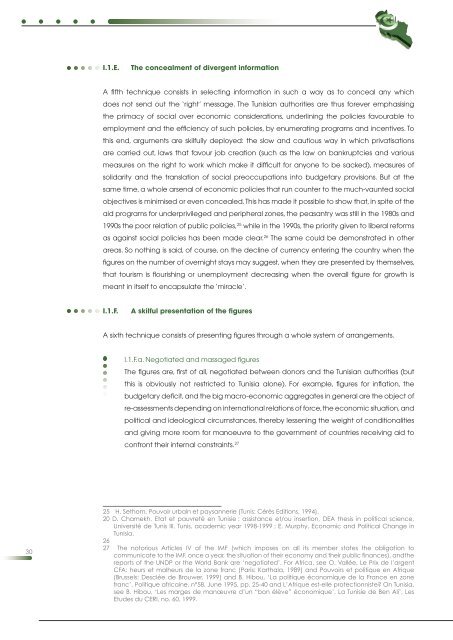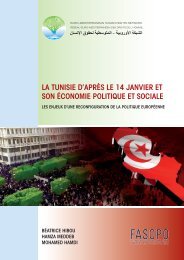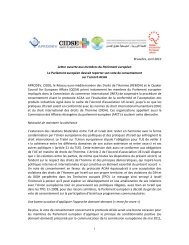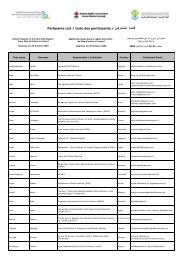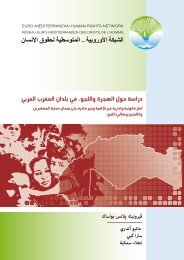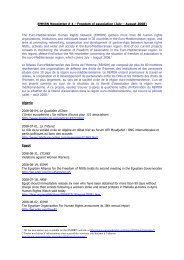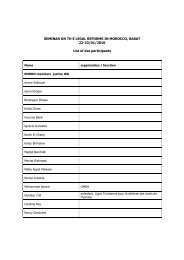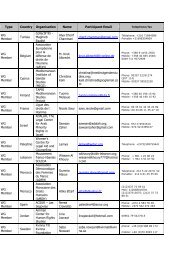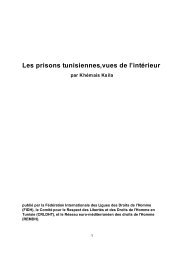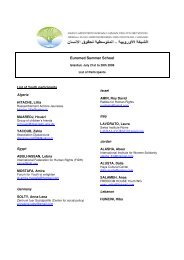I.1.E.The concealment of divergent informationA fifth technique consists in selecting information in such a way as to conceal any whichdoes not send out the ‘right’ message. The Tunisian authorities are thus forever emphasisingthe primacy of <strong>social</strong> over economic considerations, underlining the policies favourable toemployment <strong>and</strong> the efficiency of such policies, by enumerating programs <strong>and</strong> incentives. Tothis end, arguments are skilfully deployed: the slow <strong>and</strong> cautious way in which privatisationsare carried out, laws that favour job creation (such as the law on bankruptcies <strong>and</strong> variousmeasures on the right to work which make it difficult for anyone to be sacked), measures ofsolidarity <strong>and</strong> the translation of <strong>social</strong> preoccupations into budgetary provisions. But at thesame time, a whole arsenal of economic policies that run counter to the much-vaunted <strong>social</strong>objectives is minimised or even concealed. This has made it possible to show that, in spite of theaid programs for underprivileged <strong>and</strong> peripheral zones, the peasantry was still in the 1980s <strong>and</strong>1990s the poor relation of public policies, 25 while in the 1990s, the priority given to liberal reformsas against <strong>social</strong> policies has been made clear. 26 The same could be demonstrated in otherareas. So nothing is said, of course, on the decline of currency entering the country when thefigures on the number of overnight stays may suggest, when they are presented by themselves,that tourism is flourishing or unemployment decreasing when the overall figure for growth ismeant in <strong>its</strong>elf to encapsulate the ‘miracle’.I.1.F.A skilful presentation of the figuresA sixth technique consists of presenting figures through a whole system of arrangements.I.1.F.a. Negotiated <strong>and</strong> massaged figuresThe figures are, first of all, negotiated between donors <strong>and</strong> the Tunisian authorities (butthis is obviously not restricted to Tunisia alone). For example, figures for inflation, thebudgetary deficit, <strong>and</strong> the big macro-economic aggregates in general are the object ofre-assessments depending on international relations of force, the economic situation, <strong>and</strong><strong>political</strong> <strong>and</strong> ideological circumstances, thereby lessening the weight of conditionalities<strong>and</strong> giving more room for manoeuvre to the government of countries receiving aid toconfront their internal constraints. 273025 H. Sethom, Pouvoir urbain et paysannerie (Tunis: Cérès Editions, 1994).20 D. Chamekh, Etat et pauvreté en Tunisie : assistance et/ou insertion, DEA thesis in <strong>political</strong> science,Université de Tunis III, Tunis, academic year 1998-1999 ; E. Murphy, Economic <strong>and</strong> Political Change inTunisia.2627 The notorious Articles IV of the IMF (which imposes on all <strong>its</strong> member states the obligation tocommunicate to the IMF, once a year, the situation of their <strong>economy</strong> <strong>and</strong> their public finances), <strong>and</strong>thereports of the UNDP or the World Bank are ‘negotiated’. For Africa, see O. Vallée, Le Prix de l’argentCFA: heurs et malheurs de la zone franc (Paris: Karthala, 1989) <strong>and</strong> Pouvoirs et politique en Afrique(Brussels: Desclée de Brouwer, 1999) <strong>and</strong> B. Hibou, ‘La politique économique de la France en zonefranc’, Politique africaine, n°58, June 1995, pp. 25-40 <strong>and</strong> L’Afrique est-elle protectionniste? On Tunisia,see B. Hibou, ‘Les marges de manœuvre d’un “bon élève” économique’, La Tunisie de Ben Ali’, LesEtudes du CERI, no. 60, 1999.
T U N I S I A A F T E R 1 4 J A N U A R Y A N D I T S S O C I A L A N D P O L I T I C A L E C O N O M YT H E I S S U E S A T S T A K E I N A R E C O N F I G U R A T I O N O F E U R O P E A N P O L I C YFigures are then presented or concealed depending on how relevant they are to theofficial discourse. While in the case of the overall balance of payments figures it is difficultto provide erroneous data, their breakdown can more easily lend <strong>its</strong>elf to manipulation.For instance, figures on the influx of currency cannot be falsified, unlike sector-baseddata on tourism, in particular the number of overnight stays, the number of tourists, <strong>and</strong>the origins of the latter. So the Tunisian public powers have tried to conceal the problemsin the tourist sector by broadcasting the figure of a 4% increase in unitary receipts pertourist between 2000 <strong>and</strong> 2007. Now, if one takes a closer look, this figure was largelyconstructed by carrying out the assessment in local currency, <strong>and</strong> the failure to take intoaccount the continuing depreciation of the Tunisian dinar (32% between 2000 <strong>and</strong> 2007)swelled the sector’s real performances. According to the Fitch rating agency, receiptsper tourist have thus dropped over the last few years. 28 This way of presenting the figuresenables the crisis in the tourist sector to be swept under the carpet: losing 5.3% of <strong>its</strong>regional market share between 2000 <strong>and</strong> 2006 <strong>and</strong> seeing, in comparative terms, theslowest average growth in revenues in the sector, Tunisia finds that <strong>its</strong> place as a preferredtourist destination is falling, so that it comes behind <strong>its</strong> direct competitors in the southernMediterranean, Egypt <strong>and</strong> Morocco, as well as Turkey. 29Sometimes, the divergence between data is, so to speak, openly admitted, <strong>and</strong> theauthorities seek less to harmonise them than to use them in the most advantageous way,depending on the arguments deployed. Thus, just staying for the moment in the touristsector, the data of the Fitch rating agency will be used to play down the effects of the crisissince, according to this institution, this sector represents a mere 6.5% of GDP <strong>and</strong> employs380,000 people. 30 On the other h<strong>and</strong>, the official data repeated by European authoritiesare used when it is a matter of negotiating aid <strong>and</strong> additional financing, insofar as thesefigures quote a figure of some 15% of GDP for the participation of the tourist sector,representing 800,000 direct <strong>and</strong> indirect jobs, i.e. around 40% of the active population. 31These divergences may result from different ways of defining the object to be quantified,different methods used, different bases for calculation, the absence of updating, <strong>and</strong> soon. In this case, these divergences (or rather these enormous differences) are tied in witha different way of drawing up accounts in the area of tourism. The first data take intoaccount only tourism in the strict sense, while the second also consider the impact oftourism on arts <strong>and</strong> crafts (4% of GDP) <strong>and</strong> on services (3% GDP).28 See the latest report of the Fitch rating agency on Tunisian tourism, ‘L’industrie touristique tunisienne:un modèle à rénover’, December 2007. The Tunisian magazine l’Expression had also devoted a dossierto the situation of tourism in Tunisia, ‘Gros nuages sur le tourisme tunisien’, n° 39, 11 to 17 July 2008.[footnote 22 is missing in the original, I have renumbered all subsequent footnotes accordingly – AB, Tr.]29 Over the same period, Turkey, one of Tunisia’s main competitors, managed for example to increase <strong>its</strong>share in the market by 9.9%. www.webmanagercenter: ‘Tunisie: Les quatre vérités d’un secteur au bordde la sinistrose’, 12.12.2007.30 See the latest report of the Fitch rating agency on Tunisian tourism, ‘L’industrie touristique tunisienne:un modèle à rénover’, December 2007.31 Official Tunisian data for the years 2009 <strong>and</strong> 2010 noted in the draft report drawn up by the Europeanparliamentary delegation whose chair, Hélène Flautre, went to Tunisia on 3-6 February 2011. See also‘Les défis économiques de l’après Ben Ali’, L’Expansion, 19.01.2011. http://lexpansion.lexpress.fr/economie/les-defis-economiques-de-l-apres-ben-ali_247221.html.31T h e r h e t o r i c o f ‘ s t a b i l i t y ’ a n d t h e e c o n o m i c ‘ m i r a c l e ’


